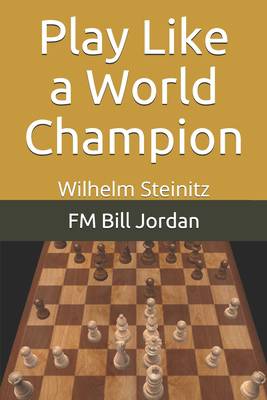
- Afhalen na 1 uur in een winkel met voorraad
- Gratis thuislevering in België vanaf € 30
- Ruim aanbod met 7 miljoen producten
- Afhalen na 1 uur in een winkel met voorraad
- Gratis thuislevering in België vanaf € 30
- Ruim aanbod met 7 miljoen producten
Omschrijving
This book features Wilhelm Steinitz who became the first official world chess champion in 1886 after defeating Johannes Zukertort in a match. He lost the title in 1894 to Lasker and also lost a rematch with Lasker with 1897. Steinitz was from Austria-Hungary, but also lived in England and USA.
Steinitz was a great positional and defensive player.How many of his moves can you guess?
Playing through GamesPlaying through master games is a proven method of improving. One method is to take one side, usually the winning side, and guess the next move. In the pre-computer era this could be done by covering up the moves with a sheet of cardboard. If you guessed correctly you will score. With practice you will correctly predict more moves. Doing so helps develop chess fluency.
One suggested approach was not to take too long on the moves, say about 10 seconds or so. You could score correct guesses. If the move was totally unexpected, then it would be a good time to see if you could understand why the move was played. Every move should have a clear idea behind it. If you cannot see the idea, there is a learning opportunity there.
Here there is between one and four choices. This is similar to a multiple choice exam. This is easier than looking at all moves and may mean you examine some moves you would not have normally considered.DiagramsThis book has many large clear colour diagrams. You do not need a chess set and board to read this book. You do need to know how to read standard chess notation.How to ScoreThis book consists of games from World Championships with brief annotations for each move. You may simply play over the games for their own sake. To get the most out of this book you play through the games and take the role of the winning player.The winning player will always be playing up the board.
Initially all the details of the games will be displayed.
For a number of opening moves you will not need to guess the move. The number will vary from game to game and will generally be between 8 and 10 moves (for each side).
After these opening moves have been played, you will then try and predict the winning player's moves. Your choice will be selected from a number of candidate moves.
If you guess correctly you will score points which will range from 0 to 6. You can either write down or otherwise keep track of your total score and see what category you reach.
RatingThe score for each game will always be out of 100. Scores may vary from game to game so to get a consistent rating average your score over 10 games.
These are based on the FIDE (The international chess federation) rating system developed by Professor Elo.
The rating of 2500+ is an approximation of the strength needed to be a Grandmaster.
After you have finished a game, find what range your score is in the left column. Your approximate rating is in the right column.
- 91-100 2500+
- 81-90 2400 - 2499
- 71-80 2200 - 2399
- 61-70 2000 - 2199
- 51-60 1800 - 1999
- 41-50 1600 - 1799
- 31-40 1400 - 1599
- 21-30 1200 - 1399
- 11-20 1000 - 1199
- 0 -10 below 1000
The challenge is to increase your rating with each game!
Further BooksDepending on feedback, I will publish further books in this series, based on the following World champions.
- Steinitz
- Lasker
- Capablanca
- Alekhine
- Euwe
- Botvinnik
- Smyslov
- Tal
- Petrosian
- Spassky
- Fischer
- Karpov
- Kasparov
- Anand
- Carlsen
Specificaties
Betrokkenen
- Auteur(s):
- Uitgeverij:
Inhoud
- Aantal bladzijden:
- 94
- Taal:
- Engels
Eigenschappen
- Productcode (EAN):
- 9781075814570
- Verschijningsdatum:
- 29/07/2019
- Uitvoering:
- Paperback
- Formaat:
- Trade paperback (VS)
- Afmetingen:
- 152 mm x 229 mm
- Gewicht:
- 149 g

Alleen bij Standaard Boekhandel
Beoordelingen
We publiceren alleen reviews die voldoen aan de voorwaarden voor reviews. Bekijk onze voorwaarden voor reviews.











